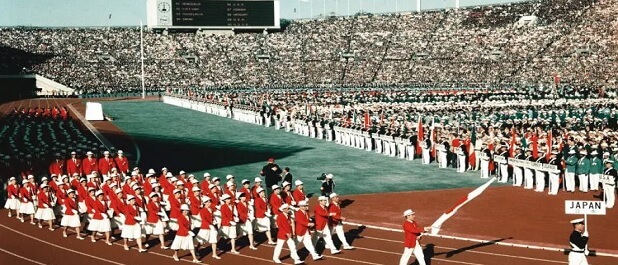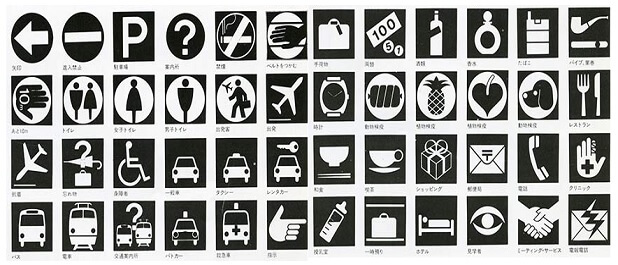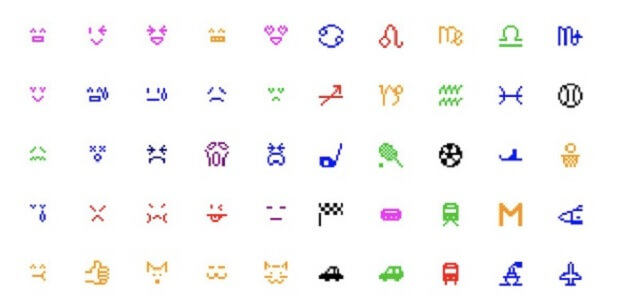Japanese "Pictograms" and "Emoji"
The modern pictograms were born in Japan!
Pictograms began as isotypes created by Otto Neurath, an Austrian social and economics scholar, around 1920. Isotypes were conceived to communicate complex social and economic situations in an easy-to-understand manner to citizens who were not accustomed to reading texts. Simply put, they are "graphs represented by pictorial symbols.
The origin of the modern pictogram is considered to be the "facility symbol" of the 18th Tokyo Olympics held in 1964. The Tokyo Olympics were the first Olympics to be held in Asia. Of the 14 modern Olympics actually held from the first in Athens to the 17th in Rome, 11 were held in Europe, two in the United States, and one in Australia. Therefore, there was no problem with alphabetical (Roman) notation in the host city.

However, in the 1960s, Japan was not as inundated with the alphabet as it is today. It was difficult to provide information about stadium, etc. to athletes and officials from more than 90 countries, who spoke a variety of languages, using only letters.
In addition, at that time, Japan was not in the era of tens of millions or more foreign tourists arriving in a year as it is today. At that time, the number of foreign tourists was only about 150,000 a year, and foreigners were a rarity. Most of the information in the facilities was written only in Japanese. Therefore, it was necessary to provide not only information about the stadium, but also public telephones, hospitals, post offices, and money exchange offices.
Therefore, Masaru Katsumi, who was the chairman of the Tokyo Olympics Design Expert Committee, decided to create a pictogram with several young designers. Among the young designers were Tadanori Yokoo, who later worked on the stage design for the Belgian National Ballet of the 20th Century and won the New York ADC Gold Prize, and Ikko Tanaka, who later designed the logos for MUJI and Loft.
This work was done on a completely volunteer basis. They met once a week to come up with a rough draft of the design without compensation. On a table in the meeting room was a pile of straw papers and many pencils, They designed by hand because there were no computers at the time. Mr. Katsumi prepared two themes for each day, such as "toilets and telephones," and they drew the draft pictogram design at the same time. When one theme was finished, the staff quickly retrieved the straw papers, and after a break for lunch, another theme was drawn.
They created 39 pictograms included not only pictograms for 23 sports, but also those for public facilities such as restrooms and police stations. Because it was a completely volunteer work, they could not get tickets, and they could not actually see with their own eyes how the pictograms were used at the stadium. The copyright was waived so that pictograms could be used freely in the future. Japan was the first country to successfully create pictograms for dozens of Olympic sports.

By the way, another Japanese pictogram that has spread around the world is the pictogram "Emoji" used in smartphones. The first use of Emoji was in 1995 with pagers(beepers) that could only transmit numbers. On Japanese pager, typing "88" could transmit a heart symbol.
In 1999, as the next means of communication after pagers, Docomo announced i-mode, which allowed users to connect to the Internet from their cell phones. In i-mode, 176 types of Emoji were available. Instead of typing "soft ice cream," people could choose one of these Emoji to convey their message. There were Emoji for emotions, animals, sports, food and more. The number of it gradually grew to as many as 300.

Emoji became popular because they are easy to use and can express feelings that cannot be expressed by letters. In 2006, Google's Japanese subsidiary established the Emoji Project to register pictograms in Unicode. Unicode is a standard for expressing characters and symbols used around the world in unified hexadecimal numbers, and is used as a standard for representing characters in Windows, Mac OS, Java, etc.. Currently, more than 1,000 pictograms are registered.
Today, Emoji are widely used and spread throughout the world. There is even an episode that President Obama said that "Emoji is a representative culture that originated in Japan and spread globally" when he met with the Japanese Prime Minister at the White House in 2015.
 Opening Lake
Opening Lake April Fool's day
April Fool's day Hanami
Hanami Baseball
Baseball